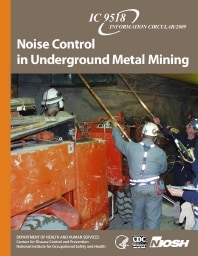Mining Publication: Noise Control in Underground Metal Mining
Original creation date: December 2009
Authors: ER Reeves, RF Randolph, DS Yantek, JS Peterson
NIOSHTIC2 Number: 20036263
Pittsburgh, PA: U.S. Department of Health and Human Services, Public Health Service, Centers for Disease Control and Prevention, National Institute for Occupational Safety and Health, DHHS (NIOSH IC) Publication No. 2010-111, IC 9518, 2009 Dec; :1-62
Noise-induced hearing loss (NIHL) is the most common occupational illness in the United States, with 30 million workers exposed to excessive noise levels [NIOSH 1996] every day. Of particular concern is the mining industry; which has the highest prevalence of hazardous noise exposure of any major industry sector [Tak et al. 2009] and is second only to the railroad industry in prevalence of workers reporting hearing difficulty [Tak and Calvert 2008]. This document is for operators, safety personnel, and mechanics in the mining industry who are not specialists in noise control engineering or acoustics. Evaluations of successful and unsuccessful attempts at controlling noise on several large, underground metal mining machines are detailed to illustrate the basic principles of noise control. Once personnel understand the guidelines and principles of noise control, they will be able to (1) evaluate the extent of a noise problem; (2) determine the best approach to the problem; and (3) apply the most appropriate solution.

NIOSHTIC2 Number: 20036263
Pittsburgh, PA: U.S. Department of Health and Human Services, Public Health Service, Centers for Disease Control and Prevention, National Institute for Occupational Safety and Health, DHHS (NIOSH IC) Publication No. 2010-111, IC 9518, 2009 Dec; :1-62